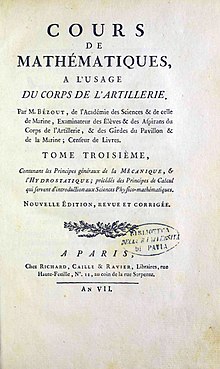Étienne Bézout (original) (raw)
From Wikipedia, the free encyclopedia
French mathematician (1730–1783)
| Étienne Bézout | |
|---|---|
 |
|
| Born | (1730-03-31)31 March 1730Nemours, Seine-et-Marne |
| Died | 27 September 1783(1783-09-27) (aged 53)Avon, Île-de-France |
| Nationality | French |
| Known for | Bézout's theoremBézout's identityBézout matrixBézout domain |
| Parents | Pierre Bézout (father)Jeanne-Hélène Filz (mother) |
| Scientific career | |
| Fields | Mathematics |
| Institutions | French Academy of Sciences |
Étienne Bézout (French: [bezu]; 31 March 1730 – 27 September 1783) was a French mathematician who was born in Nemours, Seine-et-Marne, France, and died in Avon (near Fontainebleau), France.
In 1758 Bézout was elected an adjoint in mechanics of the French Academy of Sciences. Besides numerous minor works, he wrote a Théorie générale des équations algébriques, published at Paris in 1779, which in particular contained much new and valuable matter on the theory of elimination and symmetrical functions of the roots of an equation: he used determinants in a paper in the Histoire de l'académie royale, 1764, but did not treat the general theory.
Cours de mathématiques, à l'usage du corps de l'artillerie, 1798
- Cours de mathématiques, a l'usage du corps de l'artillerie (in French). Vol. 3. Paris: Tilliard. 1798.
After his death, a statue was erected in his birth town, Nemours, to commemorate his achievements.[1]
In 2000, the minor planet 17285 Bezout was named after him.[2]
- ^ O'Connor, John J.; Robertson, Edmund F., "Étienne Bézout", MacTutor History of Mathematics Archive, University of St Andrews
- ^ "(17285) Bezout". minorplanetcenter.net. Minor Planet Center. Retrieved November 26, 2021.
- The original version of this article was taken from the public domain Rouse History of Mathematics
- Grabiner, Judith (1970–1980). "Bezout, Etienne". Dictionary of Scientific Biography. Vol. 2. New York: Charles Scribner's Sons. pp. 111–114. ISBN 978-0-684-10114-9.
 Media related to Étienne Bézout at Wikimedia Commons
Media related to Étienne Bézout at Wikimedia Commons- Étienne Bézout at the Mathematics Genealogy Project
